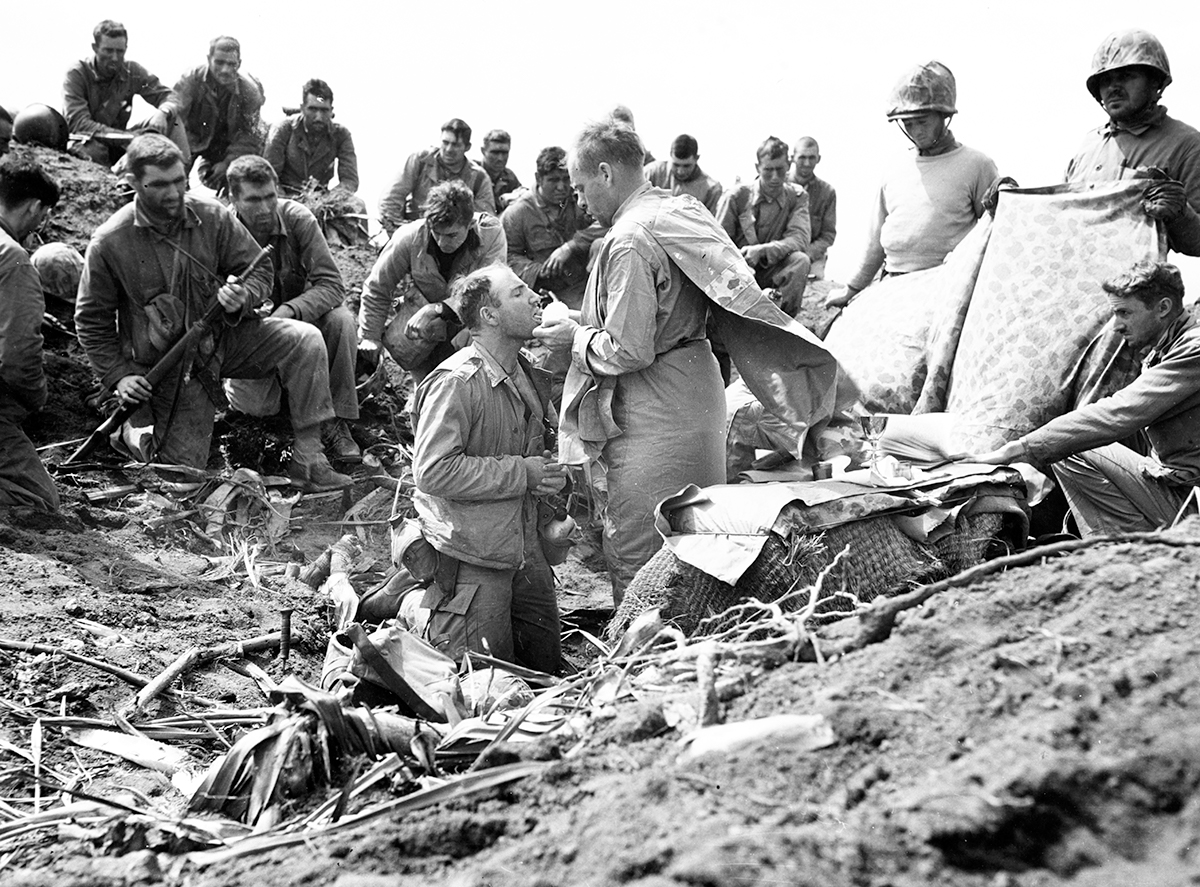Lenten Campaign 2025
This content is free of charge, as are all our articles.
Support us with a donation that is tax-deductible and enable us to continue to reach millions of readers.
Everyone knows the World War II photo of Marines raising the American flag on Iwo Jima. But few people talk about the chaplain who celebrated a Catholic Mass in the shadow of that historic event.
Fr. Charles F. Suver was a 39-year-old Jesuit priest who was one of almost 60 chaplains accompanying the Marine divisions invading Iwo Jima or working offshore with the invasion fleet. The 1945 battle was the bloodiest in the Pacific.
"There was, as one chaplain put it, 'a grand rush to the Sacraments' before the assault waves went in," wrote historian Robert Barr Smith on the website Warfare History Network. "One young officer promised to hoist an American flag on the peak of Mount Suribachi. Chaplain Charles Suver answered, 'You get it up there and I’ll say Mass under it.' Suver’s days on the beach were, in his words, “a jumble of misery and torture and suffering.” He did not exaggerate. On Iwo Jima, the attacking Marines suffered a nearly 30% casualty rate. Suver spent three days in a makeshift dressing station, comforting the wounded and the dying."
Smith continued:
Although Suver slept the sleep of sheer exhaustion on his first night ashore, Chaplain James Deasy did not. He spent most of the night crawling through Japanese shell fire from foxhole to foxhole, encouraging the men, praying over the hurt, the dying, and the dead. For five nights, Deasy kept on with almost no sleep. On the third night, he was totally buried by a Japanese shell. When Marines came to his aid, his muffled shouts ordered them to stay under cover until the Japanese shelling stopped. Only then was the chaplain pulled from his grave, shaken but still alive.
Though more than 22,000 Marines were killed or wounded during the fighting on Iwo Jima, the U.S. eventually prevailed over the Japanese, and the month-long battle proved to be a turning point.
And Fr. Suver made good on his promise. "On the fifth day of the fighting, as the national colors broke out on Suribachi and the Marines cheered, Suver and his assistant reached the top and promptly celebrated Mass while other Marines were still clearing nearby caves of diehard defenders," Smith wrote. "A board propped across two empty fuel drums was Suver’s altar, and his vestments were khaki."
The story is one of many that Smith recounts of chaplains' heroism, self-giving, and compassion during the two world wars. Titled "Means of Grace, Hope of Glory," the history was reprinted recently at the National Interest.
Saving souls and lives
Smith goes on to describe tough situations in which chaplains did everything they could to not only save souls but to save lives, even at the cost of their own. There was, for example, Fr. Aloysius Schmitt, who boosted as many men as he could through a porthole of the USS Oklahoma after it was hit during the Japanese attack on Pearl Harbor and compartments were filling up with water. Schmitt ended up drowning.
There was Fr. Francis J. Keenan, who came under fire from German aircraft while burying a soldier on the beach during the invasion of Sicily. "His arms and legs torn by fragments, Keenan went on methodically digging, while soldiers yelled to him to take cover," Smith wrote. "Keenan worked until he was satisfied with the grave, then read the burial service over the soldier’s remains. Only then did he seek medical aid for himself."
And there was Fr. Francis L. Sampson, a 32-year-old chaplain who parachuted into Normandy for the 1944 D-Day invasion. Fr. Sampson volunteered to stay in a farmhouse with men too badly hurt to be moved.
"All through one night and the following day, he divided his time between caring for the wounded men and running outside to wave a white flag at advancing German troops," Smith wrote. "At one point, Sampson was seized by two German soldiers, who prepared to shoot him. Praying hard, the chaplain heard a shot, but it was not directed at him. It came from the pistol of a German officer who fired into the air and personally took charge of Sampson, showing the chaplain the Catholic medal he carried inside his uniform and photos of his baby."
Sampson was spared. What he did next became the inspiration for the 1998 film Saving Private Ryan. Smith doesn't get into that, but his article is well worth a read.












